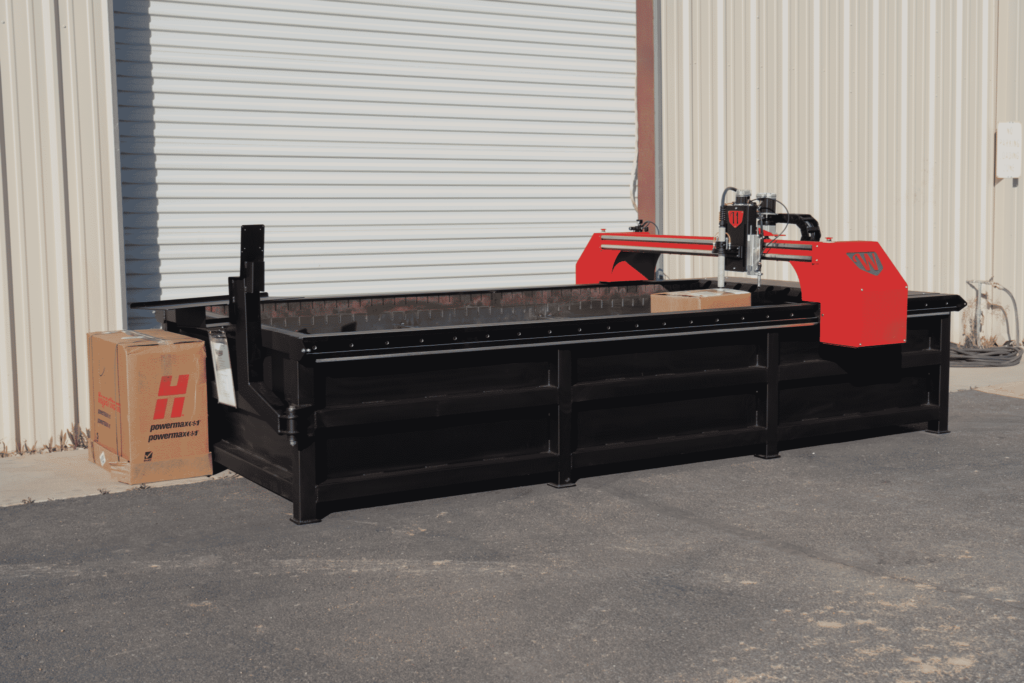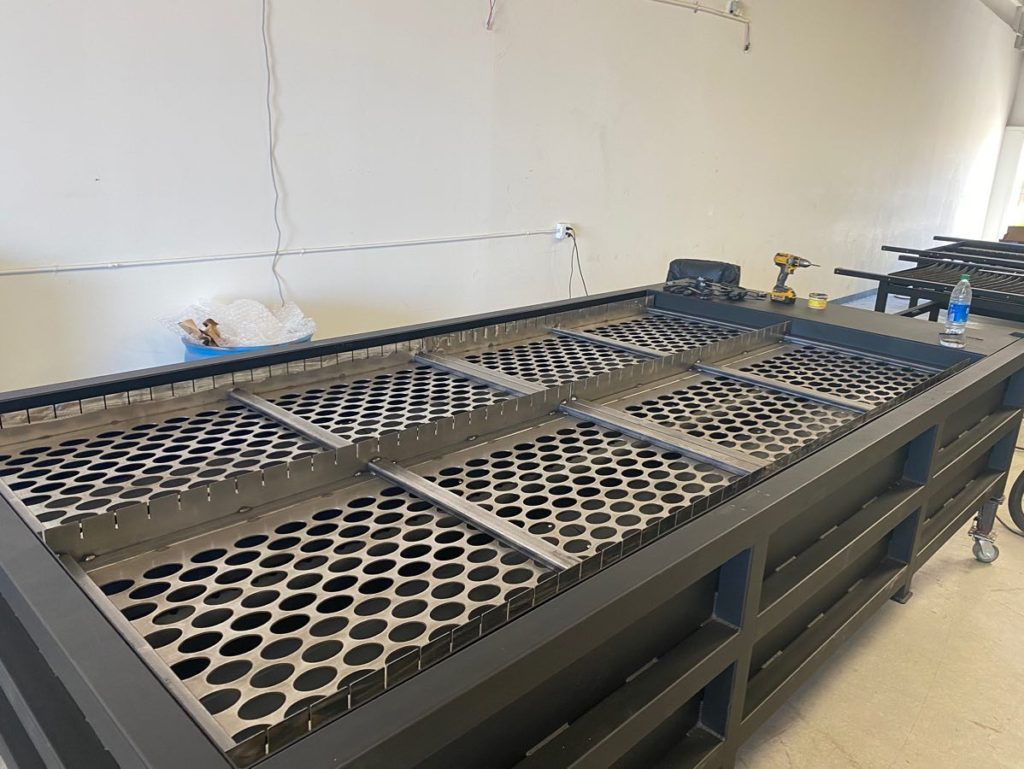Water table vs. Downdraft is about like a Ford vs. Chevy debate with some people. I’m going to try and stay as neutral as possible. For the Westcott Pro Series table, we have a CNC Plasma Water Table / Bladder design, which allows the water level to rise and lower. This is the same as a water table, only the water can rise / lower as needed. We also have a CNC Downdraft design that produces virtually no smoke whatsoever.
I’m not going to spend too much time talking about an open table, which is a table where there is no water and there is no down draft system. There are just slats for the material to sit on and nothing but ground below. This style is extremely messy and will fill your shop with a fine black dust that will coat every surface in short order. It’s obviously the least expensive option but also the worst for many reasons. Avoid this option at all costs.
let’s look at advantages and disadvantages of a downdraft system vs a water table system:
Downdraft
Advantages
- Usually less expensive to maintain once installed
- Cleaner with less secondary mess
- Drop out parts can be easier to find depending on design
- Captures about 70 to 80 percent of dust and smoke
Disadvantages
- Slightly more expensive up front
- Requires more equipment such as a fan and uses more energy
- Pulls shop air outside thus your heated or cooled shop looses its air and you could have much higher utility bills
- Warping of parts is more common due to heat
- Larger heat affected zone on parts
- Usually requires covering unused portion of table to be effective
- Parts stay hot longer and burns from handling parts are more common
- Can have zones or areas where its less effective than other areas on the table
Water Table
Advantages
- Water traps dust & smoke
- Less heat affected zone
- Less metal warping
- Does not require extra equipment or energy to operate
- Does not pull heat or AC out of the shop
- Parts can usually be picked up and handled quickly
- Captures 80-90% of dust and smoke
Disadvantages
- Can be messier and require rinsing of parts
- Requires water treatment chemicals to prevent corrosion
- Dropped parts need to be retrieved from the water and can be hard to find
- Water treatment chemicals can be expensive
- Needs to be kept from freezing in winter
So what is a Downdraft System?
With a downdraft system you are using a table design that tapers down under the table to an exhaust duct. This duct is then connected to a fan to pull the air, dust and smoke down and away from the table. If the table is not designed correctly small parts and pieces that drop down can be difficult to retrieve.
Table position in the shop is critical since you will need to place it close to an exterior wall or use a vertical stack for ventilation. The ducting can be a trip hazard and obstacle around the table. You’re going to need a large and powerful fan to pull all of that smoke and dust down. Picture a 4×8 table, you have 32 square feet of space you need to pull the air down evenly across this entire space and exceed the tendency of the smoke to rise from heat.
The design of the downdraft system is critical so that it effectively pulls the smoke and dust down over the entire area and not just the center. This is an area where I often see downdraft tables fail. They may pull the smoke and dust down when cutting over the center of the table but when cutting anywhere else its not effective. This is why Westcott Downdraft Tables pull the smoke from wherever the table is cutting. Also you need to usually cover areas not in use to increase the vacuum affect. If you have a 4×8 table and your cutting a 4×4 piece of steel, the down draft system and the air will take the path of least resistance and be pulled through the area where there is no steel and allow the dust and smoke to escape where you’re cutting.
All of the air that your pulling through this system has to come from somewhere right? That air is your heated shop air in the winter and your cooled shop air in the summer. So you’re going to be pulling hundreds of cubic feet a minute of air out of the shop. This can dramatically increase your utility bills. Venting direct to the outside is common but it can make a mess of the area where it vents and you will have the smell of smoke being pushed outside. Units to clean the air and reuse it can cost thousands of dollars. And you will have more noise and electricity use due to the operation of the fan.
Lastly with a downdraft system your metal will be hotter and stay hotter longer. Warping of thin material is much more common and will give your THC a work out keeping up with the warping material. This warped material can also be a pain to deal with when finishing the part. You can often just look at plasma cut parts and determine visually if they were cut on a water table or a downdraft. There will be a blue haze around the downdraft cut parts edges from the extra heat the metal experiences.
Okay, now what about a water table?
With a water plasma table your using a contained bed of water to capture the heat, smoke and dust. Most water tables are 4 to 6 inches deep across the entire cutting area. Some have sumps where the water can be drained off when not in use to allow for retrieval of small parts, table cleaning and to decrease evaporation rates. You can vary the water level in the table with a hose for low end tables or using air pressure in high end air bladder tables. Water level is critical to the effectiveness of the table. I have found that ¼ to 3/8 below the bottom of the material being cut works best. For certain applications like cutting Armor plate I will raise the water level and cut the plate underwater.

Because you have the water as a cooling media the material your cutting stays cooler so you have less warping and less Heat affected zone (HAZ) and discoloring around the edge of the cuts. Maintaining proper cut height is critical for getting the best quality cut, if your material stays flat and does not warp its easier for your machine to maintain the proper cut height across the sheet.
A plasma water table will help reduce the amount of noise from cutting as well, except when it cuts around open areas or edges where there is a lot of air and splashing noise. But you do not have the added noise of a fan or that added energy consumption that you would have with a downdraft system.
With a plasma water table it will be a bit messier and a bit wetter than a downdraft system. I like having a hose or a garden sprayer to wash off the parts when they are finished cutting. I also keep a small work table next to the cutting table with a towel so that I can dry and wipe off the parts after cutting. This is a step that you would not have with a downdraft, but parts are cooler and can be handled much quicker with a cnc plasma water table.
The water in your water table needs to be maintained and monitored to be effective. Check out or page on water treatment here: Water Treatment Page





